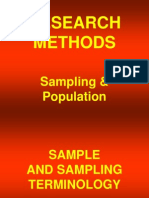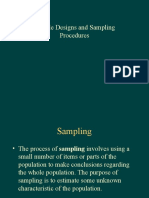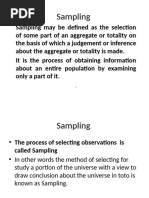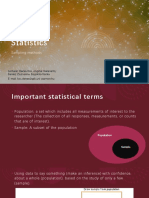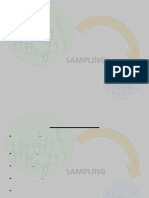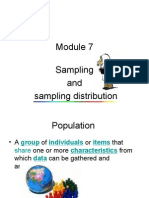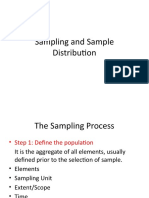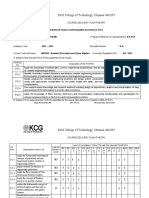Sampling Meaning of Basic Terms
Uploaded by
Spatika MgSampling Meaning of Basic Terms
Uploaded by
Spatika MgSAMPLING Meaning of Basic Terms
Population: Any finite or infinite collection of individuals sharing some common set of characteristics. Population Elements: Individual participant or object on which the measurement is taken. Census: The complete enumeration of the elements of a population. Sample: A subgroup of the elements of the population selected for participation in the study. Sampling: Selecting some of the elements in a population, from which we may draw a conclusion about the entire population. Sample Survey: A survey which is carried out using a sample.
Sampling Design Process
1. Define Target Population: Target population is the collection of elements or objects that posses the information sought by the researcher. It should be defined in terms of elements, sampling units, extent and time. Element is the object that posses the information ex. Housewives. Sampling unit is the basic unit containing the elements of the population. Ex. Household. Defining Sample frame: A representation of the elements of the target population. It could be a directory, list of members of any association etc. Before using the suitability of the frame must be examined. Whether it covers the population adequately, up-to-date, convenient. Select Sampling Technique Determine the sample Size Execute the Sample Process
2.
3. 4.
Types of Sampling Techniques
Non-probability sampling: That does not use chance selection procedure. Rather, rely on the personal judgment of the researcher. Arbitrary or conscious decision of the researcher to select the elements. Convenience, judgment, quota, snowball Probability sampling: Method in which each element of the population has a fixed probabilistic chance of being selected for the sample. Simple random, systematic, stratified, cluster(area)
Non-probality: Convenience
Obtaining a sample of such elements which are convenient to the researcher. Co-operative and easily accessible element are selected. Suitable for exploratory researches where researcher is interested in inexpensive approximation or gross estimation. Not recommended for descriptive or causal researches or marketing researches. Sometimes used even in large surveys.
Least expensive and least time consuming. High chances of biasness.
Not representative of population.
Non-probability: Judgment
A refined or improved form of convenience sampling in which element are purposely selected based on the judgment of the researcher. Based on sound judgment or expertise of researcer. Low cost, convenient and quick Subjective, the value depends on the expertise of the researcher. Does not allow generalisation Can be used when broad population inferences are not required.
Non-probability: Quota
Two-stage judgmental sampling First, the population is segmented into mutually exclusive groups based on certain characteristic such as gender, age, race etc. Second, sample elements are selected based on convenience or judgment. Quota ensures that the composition of the sample is same as the population. Characteristics within a characteristic, if not taken care-of (which is difficult), sample will not be representative. Widely used Convenient, cheaper and quick Under certain conditions obtain results close to probability methods Selection biasness No assurance of representativeness
Non-probability: Snowball
Selection of elements with desired characteristic starts with usually randomly. Subsequent respondents are selected based on the referral or information provided by the initial respondents. It substantially increases the likelihood of locating desired characteristics in the population. Low cost but time consuming Useful when identification of respondents is difficult at the beginning of the study.
Probability: Simple Random
Each element in the population has a known and equal chance of getting selected.
Every element is selected independently of every other element. Sample is drawn by a random procedure from a sampling frame. Lottery method Random table method No personal biasness Representative sample for a homogeneous population Easily understood Results are projectable and can be generalised. Expensive No assurance of representativeness Difficult to administer when population is large and dispersed
Probability: Systematic
Choosing the sample by selecting a random starting point and then picking every kth element in succession. K (skip interval)=Population size/ sample size Procedure: 1. 2. 3. 4. 5. Identify the list and number of elements in population Identify the sample size Identify skip interval Identify random start Draw sample Less costly and easier May not represent the whole population
Probability: Stratified
Two-stage sampling First, sample frame is divided into non-overlapping groups or strata such as gender, age group. Secondly, elements are selected from each stratum by a random procedure. The elements in each stratum should be as homogeneous as possible. Upto six strata. Can be proportionate or disproportionate. In proportionate, size of sample is in proportionate to the relative size of that stratum in population. In disproportionate, same sample size from each stratum is selected.
Includes all possible subpopulation- better coverage of population Difficult to identify appropriate strata. Expensive Not possible to stratify on many variables.
Probability: Cluster
First, the target population is divided into mutually exclusive and collectively exhaustive subpopulations cluster Then, a random sample of clusters is selected based on a probability sampling technique. For each selected cluster, either all the elements are selected or some elements are drawn probabilistically. No unit from the non selected unit is included. Area Sampling: Cluster sampling in which the clusters consists of geographical areas such as blocks, districts etc. Economical, convenient and easy to administer Difficult to compute and interpret result
Stratified vs Cluster
Stratified Cluster
All strata are included
A sample of clusters is chosen
Each stratum should be homogeneous
Each cluster should be heterogeneous
Strata should be heterogeneous
Clusters should be homogeneous
Needed for the entire population
Needed only for selected clusters
Elements selected from each stratum randomly
All elements from each selected cluster are included
Choice of Probability and Non probability Sampling
Probability Non-probability
Suitable for Exploratory Research
Suitable for Conclusive9 Descriptive and Causal) Researches
For homogeneous population
For heterogeneous population
Statistical considerations unfavourable
Favourable
Operational considerations unfavourable Time efficient Economical
Favourable Time consuming Costly
A Good Sample Design
True representative of the population Precision Biasness and accuracy Small sampling error Viable to the fund available Generalization with reasonable level of confidence
You might also like
- Research Methods: Sampling & PopulationNo ratings yetResearch Methods: Sampling & Population48 pages
- Introduction To Management Chapter One Rift Valley UniversityNo ratings yetIntroduction To Management Chapter One Rift Valley University31 pages
- Research Methods For Business & Management: Summer Semester - 2020/2021 Module Fourteen SamplingNo ratings yetResearch Methods For Business & Management: Summer Semester - 2020/2021 Module Fourteen Sampling27 pages
- Course 5 - Research Design - Sampling DesignNo ratings yetCourse 5 - Research Design - Sampling Design46 pages
- Research Methodology: Chapter 11-SamplingNo ratings yetResearch Methodology: Chapter 11-Sampling28 pages
- Sampling Procedures: by Dr. Mina NakawukaNo ratings yetSampling Procedures: by Dr. Mina Nakawuka44 pages
- Target Population: Rely On Probability and Non Probability0% (1)Target Population: Rely On Probability and Non Probability15 pages
- Testing, Assessing, and Evaluating Audit EvidenceNo ratings yetTesting, Assessing, and Evaluating Audit Evidence17 pages
- Sampling Design & Different Types of Sampling TechniquesNo ratings yetSampling Design & Different Types of Sampling Techniques41 pages
- Lecture 7: Sampling Techniques: Lecturer: Mr. Abdirisak Suleiman IbrahimNo ratings yetLecture 7: Sampling Techniques: Lecturer: Mr. Abdirisak Suleiman Ibrahim22 pages
- LR Q4 Week1-2 Research8 CollectionAnalysis-and-PresentationNo ratings yetLR Q4 Week1-2 Research8 CollectionAnalysis-and-Presentation8 pages
- Consider y - 1. The Stationarity Condition Is: Two Solutions of X From Are Outside The Unit Circle. 2. Rewriting The AR (2) ModelNo ratings yetConsider y - 1. The Stationarity Condition Is: Two Solutions of X From Are Outside The Unit Circle. 2. Rewriting The AR (2) Model15 pages
- 3 Free Courses That Helped Me Land My First Data Scientist Job in Amazon - by Farzad Mahmoodinobar - MediumNo ratings yet3 Free Courses That Helped Me Land My First Data Scientist Job in Amazon - by Farzad Mahmoodinobar - Medium15 pages
- Measures of Central Tendency and Dispersion/ VariabilityNo ratings yetMeasures of Central Tendency and Dispersion/ Variability35 pages
- Data Compression: Chapter - 2 Mathematical Preliminaries For Lossless Compression100% (2)Data Compression: Chapter - 2 Mathematical Preliminaries For Lossless Compression26 pages
- Statistical Analysis With Missing Data, 2nd Edition | WileyNo ratings yetStatistical Analysis With Missing Data, 2nd Edition | Wiley2 pages
- (AAPS Advances in The Pharmaceutical Sciences Series 40) James E. de Muth - Practical Statistics For Pharmaceutical Analysis - (2019)No ratings yet(AAPS Advances in The Pharmaceutical Sciences Series 40) James E. de Muth - Practical Statistics For Pharmaceutical Analysis - (2019)257 pages
- Comparing Kahoot Quizizz and Wordwall in EFL ReadiNo ratings yetComparing Kahoot Quizizz and Wordwall in EFL Readi17 pages
- (Ebook PDF) Using and Interpreting Statistics: A Practical Text For The Behavioral, Social, and Health Sciences 3Rd Edition100% (40)(Ebook PDF) Using and Interpreting Statistics: A Practical Text For The Behavioral, Social, and Health Sciences 3Rd Edition42 pages
- Download ebooks file Statistics for the Behavioral Sciences 4th Edition Susan A. Nolan all chapters100% (2)Download ebooks file Statistics for the Behavioral Sciences 4th Edition Susan A. Nolan all chapters55 pages
- Statistical Methods For Psychology 8th Edition Howell Solutions Manual 1100% (71)Statistical Methods For Psychology 8th Edition Howell Solutions Manual 121 pages
- Emicos/Cursos Dic-Ta - Dos/Pucp/Qlab/Clase/"Pd1Enc - Dfu Emicos/Cursos Dic - Ta - Dos/Pucp/Qlab/Clase/"Rerunfilecheck - CFGNo ratings yetEmicos/Cursos Dic-Ta - Dos/Pucp/Qlab/Clase/"Pd1Enc - Dfu Emicos/Cursos Dic - Ta - Dos/Pucp/Qlab/Clase/"Rerunfilecheck - CFG49 pages
- Introduction To Management Chapter One Rift Valley UniversityIntroduction To Management Chapter One Rift Valley University
- Research Methods For Business & Management: Summer Semester - 2020/2021 Module Fourteen SamplingResearch Methods For Business & Management: Summer Semester - 2020/2021 Module Fourteen Sampling
- Target Population: Rely On Probability and Non ProbabilityTarget Population: Rely On Probability and Non Probability
- Sampling Design & Different Types of Sampling TechniquesSampling Design & Different Types of Sampling Techniques
- Lecture 7: Sampling Techniques: Lecturer: Mr. Abdirisak Suleiman IbrahimLecture 7: Sampling Techniques: Lecturer: Mr. Abdirisak Suleiman Ibrahim
- LR Q4 Week1-2 Research8 CollectionAnalysis-and-PresentationLR Q4 Week1-2 Research8 CollectionAnalysis-and-Presentation
- Consider y - 1. The Stationarity Condition Is: Two Solutions of X From Are Outside The Unit Circle. 2. Rewriting The AR (2) ModelConsider y - 1. The Stationarity Condition Is: Two Solutions of X From Are Outside The Unit Circle. 2. Rewriting The AR (2) Model
- 3 Free Courses That Helped Me Land My First Data Scientist Job in Amazon - by Farzad Mahmoodinobar - Medium3 Free Courses That Helped Me Land My First Data Scientist Job in Amazon - by Farzad Mahmoodinobar - Medium
- Measures of Central Tendency and Dispersion/ VariabilityMeasures of Central Tendency and Dispersion/ Variability
- Data Compression: Chapter - 2 Mathematical Preliminaries For Lossless CompressionData Compression: Chapter - 2 Mathematical Preliminaries For Lossless Compression
- Statistical Analysis With Missing Data, 2nd Edition | WileyStatistical Analysis With Missing Data, 2nd Edition | Wiley
- (AAPS Advances in The Pharmaceutical Sciences Series 40) James E. de Muth - Practical Statistics For Pharmaceutical Analysis - (2019)(AAPS Advances in The Pharmaceutical Sciences Series 40) James E. de Muth - Practical Statistics For Pharmaceutical Analysis - (2019)
- Comparing Kahoot Quizizz and Wordwall in EFL ReadiComparing Kahoot Quizizz and Wordwall in EFL Readi
- (Ebook PDF) Using and Interpreting Statistics: A Practical Text For The Behavioral, Social, and Health Sciences 3Rd Edition(Ebook PDF) Using and Interpreting Statistics: A Practical Text For The Behavioral, Social, and Health Sciences 3Rd Edition
- Download ebooks file Statistics for the Behavioral Sciences 4th Edition Susan A. Nolan all chaptersDownload ebooks file Statistics for the Behavioral Sciences 4th Edition Susan A. Nolan all chapters
- Statistical Methods For Psychology 8th Edition Howell Solutions Manual 1Statistical Methods For Psychology 8th Edition Howell Solutions Manual 1
- Emicos/Cursos Dic-Ta - Dos/Pucp/Qlab/Clase/"Pd1Enc - Dfu Emicos/Cursos Dic - Ta - Dos/Pucp/Qlab/Clase/"Rerunfilecheck - CFGEmicos/Cursos Dic-Ta - Dos/Pucp/Qlab/Clase/"Pd1Enc - Dfu Emicos/Cursos Dic - Ta - Dos/Pucp/Qlab/Clase/"Rerunfilecheck - CFG


